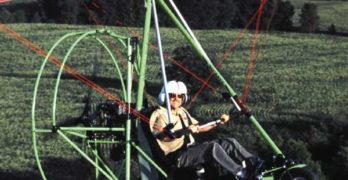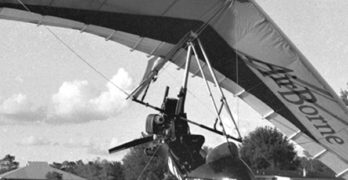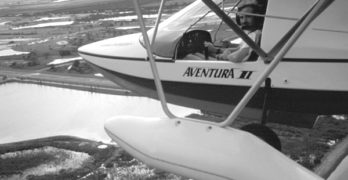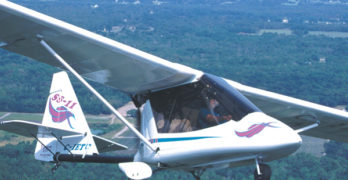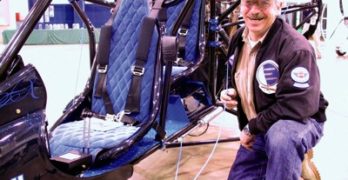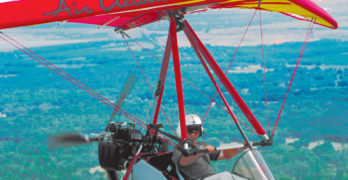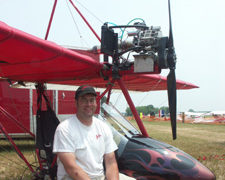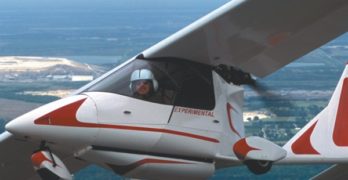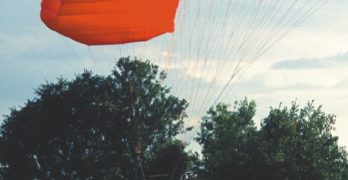I never really noticed before just how much the Buckeye Industries powered parachute carriage looked like a trike carriage. Maybe you didn’t either, but in your mind’s eye, remove the prop guard and see if you don’t agree. They aren’t identical, of course, but the visual relationship is uncannily close considering the two aircraft types developed separately.
What a perfect situation. Ralph Howard’s family members and friends have built Buckeye from “nothing” to one of the world’s largest aircraft manufacturers, all in the ’90s and without even using the entire decade! Whatever combination of talent, money, timing and luck was involved in this tale of success, the Howards want to keep it going strong. That won’t be easy, but these Indiana Hoosiers may be up to the task.
Take the momentum of a reported several hundred powered parachute units sold each of the last few years. Revise the hardware slightly to expand into the manufacture of trikes, and you have a potent mixture that could emerge as one of America’s largest trike builders.
Search Results for : Rotax electric
Not finding exactly what you expected? Try our advanced search option.
Select a manufacturer to go straight to all our content about that manufacturer.
Select an aircraft model to go straight to all our content about that model.
The AirBorne Edge
AirBorne Windsports is no johnny-come-lately to the ultralight flying scene. The Australian company has been making hang gliders for the international market for years. AirBorne’s owners – Russ and Rick Duncan – once flew for Moyes Delta Pty., another Australian hang glider company (now known for its Moyes-Bailey Dragonfly aerotug), but later branched out on their own.
While both men are thirty-somethings today, they have long experience, starting with competition in hang gliders back when folks still called them “the little Duncan brothers.” They were hot pilots at a young age. Later on, they proved to be solid competitors to the Moyes juggernaut.
Then Came Trikes
A divergence occurred. After linking up with Florida designer Bobby Bailey to produce the 3-axis Dragonfly aerotug, Moyes’s interest in trikes fell by the wayside. They focused on the already popular Dragonfly for their towing promotion.
Meanwhile, the Duncans – now on their own, producing hang gliders – engaged in building trikes.
Aventura II
If you’ve never flown an airplane on floats, you’ve missed a glorious experience in flying. Good as any ultralight on floats may be – and that means “quite excellent” in my opinion – even those pilots with that experience may have missed the unique sensation of a boat-hulled ultralight.
With a few thousand hours in my logbook covering everything from foot-launched hang gliders to twin-engined Barons, I can honestly say my absolute favorite hours are spent in one of two ways: first is soaring flight, but a close second is warm summer day flying in an ultralight floatplane.
It just doesn’t get any better.
Having stuck my personal opinion into this article, I must tell you about a most promising company and their 2-seat floatplane, the Aventura II. Since Arnet Pereyra exploded into the ultralight scene in 1995, this new company has filled out their line of floatplanes with a roomy and fun 2-seater which deserves a close look.
Eye On the Sky Watch
There was a time when a company called Beaver RX Enterprises – which produced the Canadian Beaver designs – was among the leading North American ultralight manufacturers.
In particular, the Beaver 550 tandem 2-seater attracted many customers. The company once claimed more than 3,500 ultralights flying. Certainly the model dominated the western Canadian market but also had a presence in the U.S. and other countries.
The old Beaver RX Enterprises company went through a number of leadership changes and, driven by overly-ambitious management goals, finally succumbed.
When I visited the now defunct company, the firm was a publicly-held corporation listed on the Vancouver Stock Exchange. Even the stock exchange has experienced a transformation, so perhaps it isn’t surprising that Beaver RX Enterprises also lost its heading.
As we’ve seen with other good designs, however – such as Quicksilvers, Phantoms or Drifters – the better ultralights can outlast their ownership. The Beaver line is among those survivors.
Hand Control PPC
One innovative designer offers an alternative to foot-controlled powered parachute flight.
For those of you that don’t know, most powered parachutes are steered around the sky using your legs. Pushing with your right leg exerts downward force on a steering line routed to the right trailing edge of the canopy/wing, producing drag on that side and initiating a turn in that direction.
The motion isn’t hard-though some designers have added mechanical advantage to make it easier-and the turn is more responsive that you might imagine. But what if you don’t have good use of your legs? How might you fly a powered parachute?
Canadian powered parachute manufacturer Para-Ski offers a handlebar arrangement, and other companies have experimented with similar ideas. But nearly every other supplier of these flying machines uses a foot-steering arrangement of one kind or another. James Leon of Kankakee, Illinois, has another alternative.
Call It Power Steering
While Para-Ski has its handlebars, a measure of physical effort is still involved.
FK Lightplanes FK-14
Meet the top model from FK Lightplanes.
The frenzy over the FAA’s light-sport aircraft (LSA) and sport pilot proposal continues. Pilots from ultralight to general aviation are discussing it, and the new rule may be released soon, according to those aware of FAA deliberations. We may be about to witness the birth of a new aviation segment. But unlike its predecessors, this one may come with aircraft ready to meet the need. An interesting twist on this American story is that European designs may dominate the first aircraft to fly under the rule, providing they comply with the consensus standards currently being drafted by the community.
This month, let’s meet one of the sleekest, FK Lightplanes’ Polaris FK-14 from Germany.
A Family Business
Peter and Otto Funk are the family members behind the Polaris and its siblings, the high-wing FK-9 (which has gone through three distinct versions) and the folding-wing biplane FK-12.
Air Creation Buggy/Kiss
For many years, I’ve been critical of trike handling. While I try never to forecast the future, I’ve gone out on a limb and predicted that rigid-wings will eventually become commonplace on trikes (though I don’t also predict delta wings will disappear).
Going Rigid?
Rigid-wings look a lot like modern hang gliders and trike wings in many ways, but they have control surfaces. Because these surfaces are deployed via weight-shift movements they neatly combine the benefits of 3-axis ultralights – lower control forces and good control authority – with the elegant simplicity of weight-shift. Rigid-wings can carry good weight and are somewhat faster than delta wings (called “flex wings” by hang glider pilots), and they also handle more easily. I think this makes them a nearly inevitable development.
While I still believe rigid-wings are coming to trikes, it may take longer than I thought because the trike industry may finally be rising to the challenge.
Innovating for Part 103 Ultralights
How can a Part 103 use a four-stroke engine? Well, you can elect the half-VW from Hummel…or you might try a rotary engine as seen at the 2005 Mid-Atlantic Fly-in. This innovative racing cart engine is being developed for Part 103 ultralight use (yes, to make the weight, with electric starter!) by Erik Pederson, the new president of Phantom Aeronautics. Impressively educated, Eric has a BS in Aero Engineering plus an MS and PhD in Mechanical Engineering. Watch for a test report when Erik is satisfied with the performance.
All the Plane You May Want
Over the years, Titan Aircraft has made their Tornado a familiar aircraft seen at flight parks and airports around the nation. Since it was introduced in ’91, the sleek, efficient plane has evolved into a variety of models.
This month we examine the fine work of Roger Bacon who created a lovely red-and-white Tornado II 912, powered by the 100-hp Rotax 912S 4-stroke powerplant expected to be commonplace on light-sport aircraft. Bacon’s airplane is licensed in the Amateur-built category but its facts and figures suggest it could be flown with FAA’s proposed Sport Pilot certificate (until FAA’s new rule is introduced, a private pilot’s certificate or better is required).
Usually I prefer to fly a factory airplane to make sure it correctly represents what a buyer might receive. However, Bacon’s model is so well done, Titan Aircraft encouraged a test flight. Thanks to Bacon for his willingness to let me take his pride and joy aloft.
Hybrid Powered Chute
As focus sharpens on FAA’s proposed Light-Sport Aircraft regulation, the first aircraft segment to complete an ASTM airworthiness consensus standard is powered parachutes. While these aircraft are simpler, which helped speed the process, participating manufacturers got together well and hammered out their certification rules efficiently.
Summit Powered Parachutes of Canada hasn’t yet chosen to enter the Light-Sport Aircraft arena. They aren’t worried, just wary of new regulations. In fact, the company started work under England’s BCAR S regulation. Just recently, Summit was working to qualify for German DHV certification. They see no great challenge passing the proposed U.S. powered parachute standards, as currently defined.
Fortunately, the proposed Light-Sport Aircraft is not the only destination in sport aviation. It may be part of the spectrum of aviation regulations.
We’re seeing more new designs tuned to Part 103. And the Amateur-Built 51% rule will still allow many 2-seat ultralights to be built and flown as they are today.
- « Previous Page
- 1
- …
- 24
- 25
- 26
- 27
- 28
- …
- 36
- Next Page »


